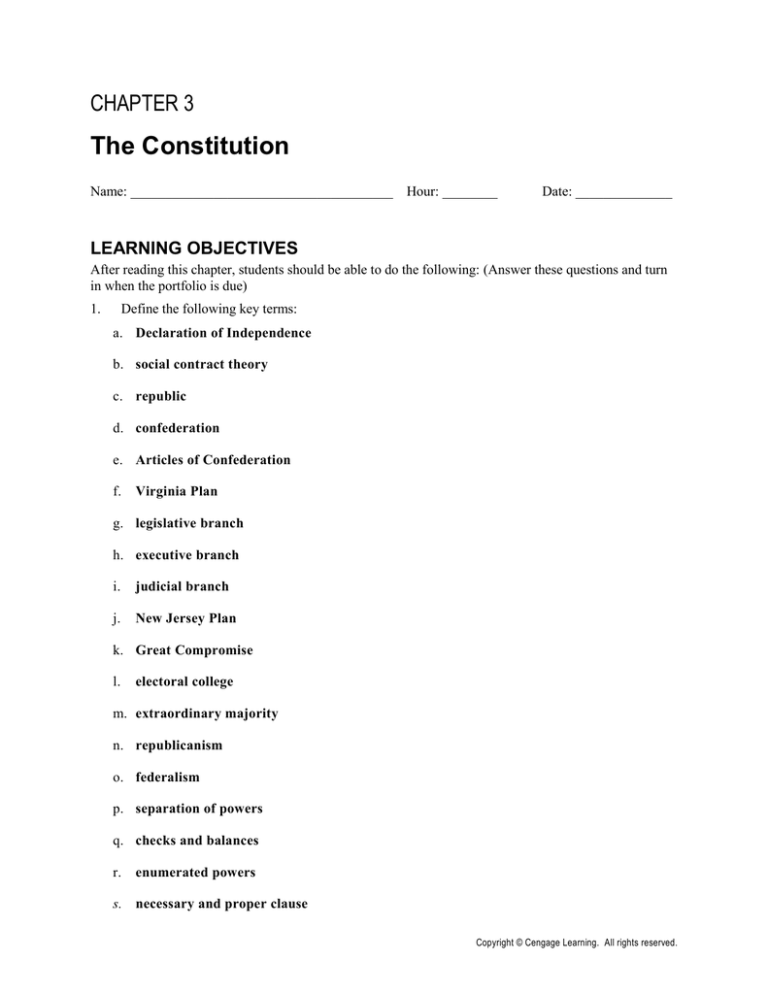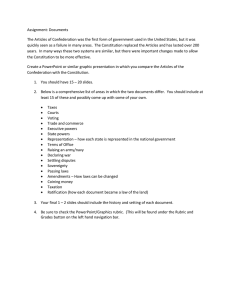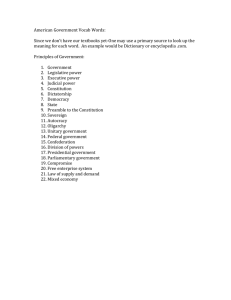
CHAPTER 3
The Constitution
Name: ______________________________________ Hour: ________
Date: ______________
LEARNING OBJECTIVES
After reading this chapter, students should be able to do the following: (Answer these questions and turn
in when the portfolio is due)
1.
Define the following key terms:
a. Declaration of Independence
b. social contract theory
c. republic
d. confederation
e. Articles of Confederation
f.
Virginia Plan
g. legislative branch
h. executive branch
i.
judicial branch
j.
New Jersey Plan
k. Great Compromise
l.
electoral college
m. extraordinary majority
n. republicanism
o. federalism
p. separation of powers
q. checks and balances
r.
enumerated powers
s. necessary and proper clause
Copyright © Cengage Learning. All rights reserved.
Chapter 3: The Constitution
t.
29
implied powers.
u. judicial review
v. supremacy clause
w. Bill of Rights
2.
Summarize the revolutionary roots of the Constitution.
3.
Explain the basic facts of the Watergate crisis and why it posed a constitutional crisis.
4.
Discuss the function of the Electoral College.
5.
What accounted for the failure of the Articles of Confederation.
6.
Explain the role of the Sons of Liberty.
7.
Outline the main features of the Virginia and New Jersey plans and describe the major compromises
made by the delegates to the Constitutional Convention (the “Great Compromise”).
8.
Explain the four basic principles underlying the Constitution and show how they reflected
Americans’ revolutionary values.
9.
Summarize the provisions of each of the seven articles of the Constitution.
10. Argue pro and con whether the Constitution is a “conservative document written by wealthy men to
advance their own interests”.
11. Summarize the key distinctions between the Federalists and Antifederalists.
12. Summarize the key components of Federalism.
13. Argue whether or not the new U.S. Constitution established a majoritarian or pluralist democracy.
14. Explain why and how the promise of a bill of rights was used to ensure ratification of the
Constitution.
15. Describe the formal and informal processes of constitutional change.
CRITICAL THINKING QUESTIONS FOR CLASS DISCUSSION
16. What does the Preamble to the Constitution really do?
17. If you were to add or remove an amendment from the U.S. constitution, which amendment would it
be? Why?
18. Is the U.S. Constitution biased more toward freedom or equality?
------------------------------------------------------------------------------------------------------------------------------(The following information is for your information only. You do not need to answer anything
below. Use it to help you throughout the chapter).
CHAPTER SYNOPSIS
The U.S. Constitution is the world’s oldest written governing instrument. Although the delegates to the
Constitutional Convention were originally charged only with revising the weak Articles of Confederation, they
overstepped their mandate and created an enlightened and enduring blueprint for consensual government.
American independence from British rule was spurred by the desire to preserve the liberties that the colonists had
achieved. Restrictions on property inheritance, religious practices, and economic mobility were common in Europe
but were minimal in America. The colonists were also determined to forestall taxation by a remote British
government in which the colonists had no representation.
Copyright © Cengage Learning. All rights reserved.
30
Chapter 3: The Constitution
The Declaration of Independence was the colonists’ response to punitive taxation and colonial restiveness. It was a
justification for severing all political connections to the British Crown. The declaration was the work of Thomas
Jefferson. He presented a clear and masterful argument for the inalienability of the people’s rights to life, liberty,
and the pursuit of happiness and the right to be governed by an authority of their choice. Jefferson based his
argument on the ideas of the English philosopher John Locke, including the right of the people to revolt against the
government’s usurpation of legitimate rights.
The colonists declared their new government a republic, a government without a monarchy. It would be rooted in
the consent of the governed, and power would be exercised by representatives who were responsible to the
governed. American colonial leaders were fearful of democracy, which was associated with mob rule and
instability.
The first attempt at government was the Articles of Confederation. The Articles proved inadequate, because they
established a national government largely devoid of power. The Articles retained power in the states, pacifying those
who feared the loss of liberty at the hands of a remote national government. Government under the Articles was
unable to cope with economic problems and the threat of insurrection.
Delegates to the Constitutional Convention realized the need for a stronger national government to preserve order.
At the outset, the Virginia delegation proposed a long list of changes to strengthen the national government. This
plan became the focus of debate and the basis for an entirely new government charter. An alternate plan, drafted by
the delegates from New Jersey, appealed to the smaller states. The Great Compromise helped to resolve the
stalemate between the two plans.
The Constitution articulates four significant political values. Republicanism is a form of government in which
power resides in the people and is exercised by their elected representatives. Federalism is the division of
sovereignty between the states and the national government. The Constitution created a national government.
Separation of powers is the assignment of lawmaking power to a legislative branch, law-enforcing power to an
executive branch, and law-interpreting power to a judicial branch. The constitutional system of checks and
balances is a means of giving each branch of government some scrutiny over the other branches. The idea of
dividing power was to prevent tyranny by a single person or group.
The first three articles of the Constitution establish the internal operation and powers of the separate branches of
government. The remaining four define the relationships among the states, explain the process of amendment,
declare the supremacy of national law, and explain the procedures for ratifying the Constitution.
The new Constitution lacked a bill of rights. This proved to be an impediment to the Constitution’s ratification.
Ratification proceeded only on the condition that a bill of rights would be added by amendment. By 1791, ten
amendments embodying these rights and liberties had been adopted by the states.
The Constitution is a simple structural framework for a government that balances freedom and order but pays
virtually no attention to social equality. The framers of the Constitution intended to create a republic that would rest
on majority consent, not majority rule. Contemporary American government conforms to a pluralist model of
democracy, which may have been what the delegates to the Constitutional Convention had in mind when they
fashioned their new government.
CHAPTER OUTLINE
I.
The Revolutionary Roots of the Constitution
A. Compared with What? The Longevity of Constitutions
B. Freedom in Colonial America
C. The Road to Revolution
D. Revolutionary Action
1. The Declaration of Independence
a. Social Contract Theory
II. From Revolution to Confederation
A. The Articles of Confederation
1. Disorder Under the Confederation
a. Shays’s Rebellion
B. The Virginia Plan
1. Legislative Branch
Copyright © Cengage Learning. All rights reserved.
Chapter 3: The Constitution
31
2. Executive Branch
3. Judicial Branch
C. The New Jersey Plan
1. A Single-Chamber Legislature has the Power to Raise Revenue and Regulate Commerce.
2. States have Equal Representation in the Legislature and Choose its Members
3. Multiperson Executive
4. Creation of a supreme Tribunal
5. Legislative Acts are Binding to the States
6. Compromise on the Presidency
a. Electoral College
D. The Great Compromise
E. The Final Product
1. The Basic Principles
a. Republicanism
b. Federalism
c. Separation of Powers
d. Checks and Balances
2. The Articles of the Constitution
a. The Enumerated Powers
b. Judicial Review
c. Supremacy Clause
3. The Framers’ Motives
4. The Slavery Issue
III.
Selling the Constitution
A. The Federalist Papers
B. The Bill of Rights
IV.
The Formal Amendment Process
A. Political Practice
V.
An Evaluation of the Constitution
A. Freedom, order and Equality in the Constitution
B. The Constitution and Models of Democracy
INTERNET RESOURCES
The Claremont Institute www.Claremont.org
Learn about Natural Law and the U.S. Constitution.
Comparing the World’s Constitutions http://confinder.richmond.edu/
Learn and read more about the constitutions of the world.
The Continental Congress and the Constitutional Convention on the Web
http://memory.loc.gov/ammem/collections/continental/
The Library of Congress presents original documents relating to the drafting and ratification of
The Charters of Freedom http://www.archives.gov/national-archives-experience/charters/charters.html
Tour the National Archives’ virtual exhibit of founding documents.
The Federalist Papers http://thomas.loc.gov/home/histdox/fedpapers.html
Learn and read more from the Federalist papers.
Constitution Day (September 17) www.constitutionday.com
Learn more about the annual celebration of the U.S. Constitution, which began in 1997.
Copyright © Cengage Learning. All rights reserved.
the Constitution.







